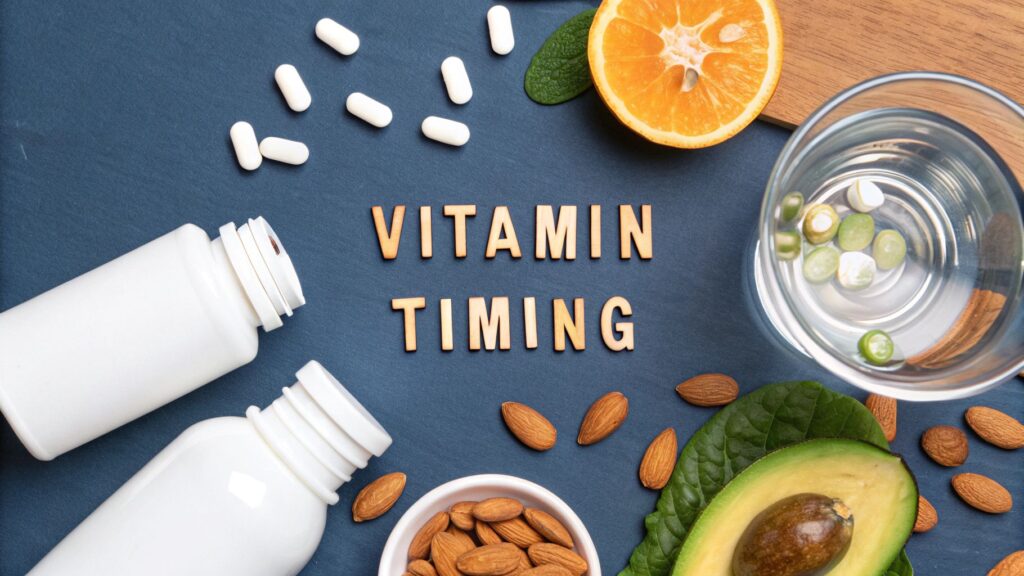Figuring out the best time to take your vitamins is a lot simpler than most people think. It really boils down to one key idea: fat-soluble vitamins (like A, D, E, and K) need a little fat to get absorbed, so you should take them with a meal. On the other hand, water-soluble vitamins (the B-complex vitamins and vitamin C) are usually happiest on an empty stomach.
Making this small adjustment is the secret to unlocking their full potential.
Your Simple Guide to Vitamin Timing

Welcome to your quick-start guide for making your supplements work harder for you. The world of vitamins can feel like a complex puzzle, but understanding a single core principle changes everything. When you take your vitamins can dramatically change how well your body absorbs and actually uses these essential nutrients.
Think of it like watering a plant. You wouldn't pour water onto sun-baked, hardened soil; you'd do it when the soil is ready to soak it all in. In the same way, your body has optimal windows for absorbing different types of nutrients. Giving your body vitamins at just the right moment ensures you get the maximum benefit from every single dose.
Setting the Foundation for Better Health
This guide is designed to take the guesswork out of the equation. We’ll start with the basics and build up to practical, real-world tips you can start using today. Getting these fundamentals right is the first step toward creating a truly effective and personalized supplement routine.
Here are the key principles we'll cover:
- The Two Vitamin Groups: We'll explore the critical difference between fat-soluble and water-soluble vitamins.
- Meal Pairing: You'll learn exactly what to eat with certain vitamins to supercharge their absorption.
- Creating a Schedule: We’ll give you simple tips for building a routine that fits seamlessly into your lifestyle.
By simply aligning your supplement intake with your meals and daily schedule, you can turn a good habit into a great one. It’s a small change that offers a significant return on your investment in health.
This journey begins with understanding the "why" behind vitamin timing. While oral supplements are a fantastic tool, for those seeking even more direct and efficient nutrient delivery, options like injectable vitamins can offer another path to wellness. The following sections will give you the deeper insights needed to make informed choices, ensuring every vitamin you take fully contributes to your health goals.
Why Fat-Soluble and Water-Soluble Vitamins Are Different
Not all vitamins play by the same rules. If you want to get the most out of your supplements, understanding one key difference is the absolute first step: how they dissolve and enter your system. This simple concept is the foundation for figuring out the best time to take vitamins and building a schedule that actually works.
Think about what happens when you try to mix oil and water—they refuse to blend and immediately separate. This is the perfect analogy for how the two main groups of vitamins behave inside your body. One group only mixes with fat, and the other only mixes with water.
The Role of Fat in Vitamin Absorption
The fat-soluble vitamins—that’s A, D, E, and K—are the "oil" in our analogy. They simply do not dissolve in water. To get from your digestive tract into your bloodstream where they can be used, they need a little help from dietary fats.
Without fat, these vitamins have a hard time making it through the digestive wall. It's like a VIP guest who needs a special escort to get past security; for these nutrients, fat is that essential escort. This is precisely why taking a vitamin D supplement on an empty stomach is far less effective than taking it with a meal containing some healthy fats.
The core principle is simple: To absorb fat-soluble vitamins, you must consume them with a meal or snack that contains fat. This ensures they are properly dissolved and transported where your body needs them most.
This infographic helps visualize when a morning boost of vitamins can be most effective, especially when paired with a balanced breakfast.

The image drives home the importance of context, showing how integrating supplements into a daily routine, like a solid breakfast, sets the stage for optimal absorption.
The Simplicity of Water-Soluble Vitamins
On the other hand, water-soluble vitamins have a much more straightforward path. This group includes vitamin C and all the B vitamins (like B12, B6, and folate). True to their name, they dissolve easily in water.
Picture stirring sugar into a glass of water—it disappears and integrates seamlessly. Water-soluble vitamins act the same way in your body. They are absorbed directly into the bloodstream along with water and don't need fat or food to be effective.
Because they are absorbed so readily, your body doesn't hang on to them for long. Any excess is typically flushed out through your urine, usually within a day. This means you need a consistent, daily supply to keep your levels where they need to be, making regularity key. This "use-it-or-lose-it" nature is a defining feature of all water-soluble nutrients.
Getting the Most from Your Fat-Soluble Vitamins
When it comes to fat-soluble vitamins—A, D, E, and K—timing and pairing are everything. Think of these vitamins as exclusive guests who need a special invitation to enter your system. That invitation is dietary fat.
Taking these supplements alongside a meal or snack containing healthy fats is like giving them a VIP escort. The fat carries these essential nutrients through your digestive tract and into your bloodstream where they can actually get to work. Without that fat, the vitamins might just pass right through, having little to no effect. This simple concept is a game-changer. It means when you take these nutrients is just as important as remembering to take them in the first place.
This doesn’t mean you need to sit down to a heavy, greasy meal. The amount of fat needed for this process is surprisingly small. Just a little healthy fat is more than enough to do the job right.
Smart Food Pairings for Better Absorption
Once you know the secret, weaving these vitamins into your day becomes second nature. You can easily turn any meal or snack into a powerhouse for absorption with a few simple additions. These foods are the vehicles your vitamins need to reach their destination.
Here are a few easy and practical ideas to get you started:
- Breakfast Boost: Stir a spoonful of nut butter into your morning oatmeal, spread some avocado on your toast, or blend a handful of chia seeds into your smoothie.
- Lunchtime Lift: Drizzle a good olive oil over your salad, add a side of salmon, or enjoy a cup of full-fat yogurt.
- Dinner Dynamics: Sauté your vegetables in a bit of coconut oil, sprinkle some cheese on your pasta, or munch on a handful of nuts before your main course.
The real key here is consistency. It’s not about the amount of fat, but the simple habit of pairing it with your supplement. A small, thoughtful addition of fat is all it takes to make sure you’re getting every bit of value from your vitamins.
The Science Behind the Strategy
This mealtime strategy isn't just a good idea—it's backed by solid science. The body's ability to actually use fat-soluble vitamins is completely dependent on consuming them with fat. Research has shown this time and time again.
For example, one study found that taking vitamin E with a fortified cereal resulted in a very high absorption rate. But when the same vitamin was taken as a standalone pill without any food, it was largely ineffective. This really highlights the critical role that food plays in unlocking the power of your supplements. If you're curious about the details, you can dig into the research on vitamin E absorption findings yourself.
So, the next time you reach for your vitamin D or a multivitamin that includes these fat-soluble nutrients, just make sure it's part of a meal. This tiny shift in your daily routine is one of the most powerful things you can do to ensure these nutrients are fully available to support your health.
The Best Way to Take Water-Soluble Vitamins

When it comes to water-soluble vitamins—like the entire B-complex family and vitamin C—you can toss out the rulebook we just established for their fat-soluble cousins. These nutrients play a completely different game, and thankfully, it’s a much simpler one.
Think of these vitamins as incredibly self-sufficient. Since they dissolve right in water, they don't need a big meal or any dietary fat to get absorbed. In fact, taking them with food can sometimes just get in the way. That's why the best approach is often the most direct: take them on an empty stomach with a simple glass of water, giving them a clear path into your system.
Morning Timing for an Energy Boost
Beyond just taking them without food, the time of day you choose can make a big difference in how you feel. This is especially true for the B-vitamin family, which is at the heart of your body’s energy production, helping convert the food you eat into fuel.
Taking your B vitamins first thing in the morning can give you a clean, natural boost to power through your day. For those who need a more potent lift, options like B-12 injections for energy can offer a more targeted approach. On the flip side, taking them late at night could be counterproductive, potentially interfering with your ability to wind down for a good night's rest.
Key Takeaway: Water-soluble vitamins are best taken on an empty stomach with water, ideally in the morning. Your body doesn’t store them, so consistent daily intake is crucial for maintaining optimal levels.
The Use-It-or-Lose-It Principle
Unlike fat-soluble vitamins that your body can tuck away for later, water-soluble vitamins work on a strict "use-it-or-lose-it" basis. Your body takes what it can use right away, and any extra is typically flushed out through your urine within just a few hours.
This has two important implications for your supplement routine:
- Consistency is Key: You need to replenish your supply every single day. A steady, consistent routine is far more effective than taking them sporadically.
- Overdosing is Rare: Because your body naturally gets rid of the excess, it’s much harder to reach toxic levels. Of course, it's still smart to stick to the recommended dosages.
This rapid turnover means timing your intake for maximum benefit is a simple but powerful strategy. The energizing effects of Vitamin B12, for instance, make it a perfect fit for your morning routine. Taking it too late might just disrupt your sleep. By understanding these simple principles, you can make sure your body gets a steady, useful supply of these vital nutrients right when it needs them most.
Building Your Personal Vitamin Schedule
Now that you know the why behind vitamin timing, let's turn that science into a simple routine you can actually stick with. Creating a personal schedule isn't about following a bunch of rigid rules; it's about making smart tweaks that fit your body and your life. The best plan is always the one you don't even have to think about.
Think of it as building a simple blueprint for your health. We’ll walk through a few common situations to help you create a plan that feels effortless but still delivers the results you want. Consistency is everything, so let's make it easy.
Handling The All-In-One Multivitamin
The first question most people ask is about their multivitamin. Since it’s a mix of both fat-soluble and water-soluble vitamins, when should you take it?
The answer is simple: prioritize the needs of the fat-soluble nutrients (A, D, E, and K). Getting them absorbed is the trickiest part of the whole equation. Because of this, the best time to take your multivitamin is always with a meal that contains some healthy fat. This one move ensures those crucial fat-soluble components are absorbed properly.
Taking it with breakfast is a popular and effective strategy. It helps lock in the daily habit and gives your body a flood of essential nutrients to kick off the day.
Pro Tip: If your go-to breakfast is fat-free (like plain oatmeal with water or a simple piece of fruit), try adding a handful of nuts, a spoonful of chia seeds, or just take your multivitamin with lunch instead.
Managing Vitamins Around Medications
This is where you need to be extra careful. Combining supplements and prescription medications requires a smart, coordinated plan, because some vitamins can seriously interfere with how drugs work. A one-size-fits-all approach here isn't just ineffective—it's unsafe.
- Vitamin K: This vitamin is famous for reducing the effectiveness of blood thinners like warfarin.
- Iron & Calcium: These two common minerals can get in the way of your body absorbing thyroid medications properly.
- St. John's Wort: This herbal supplement has a long list of interactions, affecting everything from antidepressants to birth control pills.
Because these interactions can have serious health consequences, it is absolutely essential to speak with your doctor or pharmacist. They can help you map out a staggered schedule so that both your vitamins and your medications can work effectively without tripping over each other. Never mix them without getting professional advice first.
Adapting Your Schedule for Your Lifestyle
Your daily routine is the ultimate guide for when to take your vitamins. A standard 9-to-5 schedule creates a different set of needs than working the night shift or practicing intermittent fasting.
For Night Shift Workers:
Your "morning" is whenever you wake up, even if it’s 4 PM. That's the time to take your energizing B-complex and other water-soluble vitamins. Then, pair your fat-soluble vitamins or multivitamin with your first real meal of the day (your "dinner" before heading to work).
For Intermittent Fasters:
This one is pretty straightforward. Take your water-soluble vitamins with a glass of water during your fasting window. Then, save your fat-soluble vitamins and your multivitamin for your first meal when you break your fast, making sure it includes those healthy fats.
Ultimately, the most important piece of advice is to listen to your body. If a certain vitamin upsets your stomach on an empty stomach, try it with a small snack. If B vitamins make you feel a little too wired at night, make them a morning-only habit. For those who are really looking to fine-tune their physique and performance, understanding how to stack different supplements is the next level. You can explore our advanced guide on supplements that boost HGH levels for more in-depth strategies.
At the end of the day, your ideal schedule is the one that makes you feel your best.
Your Vitamin Timing Questions Answered
Even with a solid plan, you're bound to have questions. Building the right supplement routine is a personal process, and it’s completely normal to get stuck on the small details. This section is here to tackle the most common questions we get about vitamin timing, giving you clear, straightforward answers so you can feel confident in your approach.
Let’s clear up any lingering confusion and get the final pieces of your supplement puzzle locked into place.
What Happens If I Take Vitamins at the Wrong Time?
Taking a vitamin at a less-than-ideal time isn't usually a cause for alarm, but you might be short-changing yourself. In short, you could be wasting money and not getting the full health benefits you paid for.
Think of it like this: if you take a fat-soluble vitamin like D without any fat in your meal, your body might only absorb a tiny fraction of it. For water-soluble vitamins, taking them with a huge meal could slow down their absorption, but the effect is generally less pronounced.
The real issue is reduced effectiveness, not a direct health risk. The main exception is for those with sensitive stomachs, as some vitamins can cause a bit of nausea if taken without food. The goal is simply to maximize your investment by helping your body get every bit of value from your supplements.
When Is the Best Time to Take a Multivitamin?
This is probably the most frequent question we hear, and luckily, the answer is pretty simple. Because multivitamins contain both fat-soluble and water-soluble vitamins, your best bet is to take them with a meal that includes some healthy fat.
This single step ensures the fat-soluble players—A, D, E, and K—have the ride they need to get absorbed properly. That’s the most important hurdle to clear. While this timing might slightly slow the absorption of the water-soluble vitamins, making sure the fat-soluble ones get in is far more critical for your multi to do its job.
Taking your multivitamin with breakfast is a fantastic habit to build. It creates consistency, links the pill to an event you won't forget, and starts your day with a full spectrum of essential nutrients.
Can I Take All My Vitamins and Medications at Once?
This is where you need to be extremely careful and, most importantly, talk to a professional. You should never assume it's safe to take all your supplements and medications together without first checking with your doctor or pharmacist.
Certain vitamins and minerals can seriously interfere with how prescription medications work, potentially making them less effective or, in some cases, causing harmful side effects.
- Vitamin K is famous for interfering with blood-thinning medications.
- Iron and Calcium can latch onto thyroid medication, reducing its absorption and effectiveness.
- Magnesium and Zinc can get in the way of certain antibiotics and blood pressure drugs.
Because these interactions can have serious health consequences, it is absolutely critical to speak with your doctor or a pharmacist before combining supplements and medications. They can help you create a staggered schedule to ensure both your prescriptions and your vitamins work as intended without canceling each other out. Your health depends on getting this right.
This kind of careful planning ensures you get the full benefit from every part of your wellness routine. Ultimately, creating a smart, informed supplement schedule is one of the most powerful steps you can take toward reaching your health goals.
At Elite Bioscience, we believe in empowering you with the knowledge and tools to take control of your health. Explore our range of third-party tested therapies and find the right support for your wellness journey at https://elitebioscience.co.







